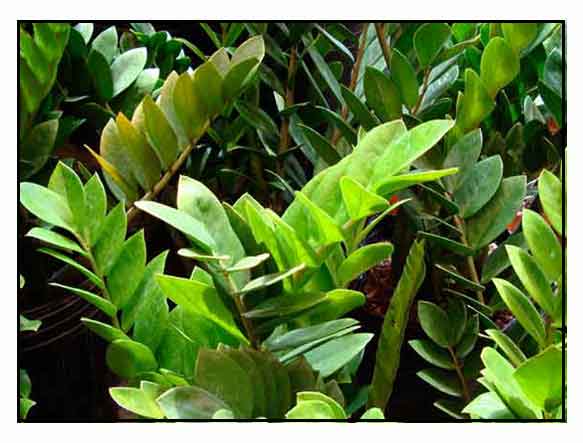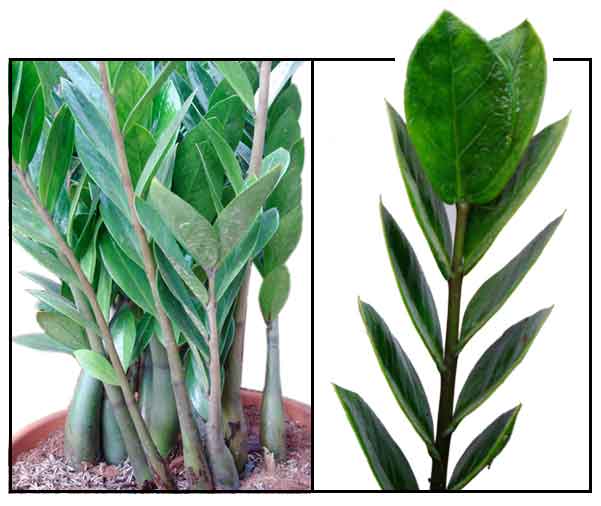|
- Snippets
- Zamioculcas is a genus of flowering plant in the Araceae family, with the single species Zamioculcas.
- Zamioculcas zamiifolia, is a unusually drought resistant medicinal plant native to tropical east Africa and subtropical southeast Africa, considered a living fossil which may have evolved as early as 42 million years ago. (7)
- First described in 1829 by Loddiges as Caladium zamiifolium, and moved to genus Zamioculcas in 1856 by Heinrich Wilhelm Schott, and eventually established as Zamioculcas xamiifolia by Adolf Engler in 1905. (7)
Botany
Zu zu plant is an evergreen plant that
grows from a stout underground, succulent water-storing rhizome, attaining
a height of 45 to 60 centimeters. Leaves are pinnate, 40 to 60 centimeters long, with 6-8 pairs
of leaflets 7 to 15 centimeters long, smooth, shiny and dark green. Flowers are
small bright yellow to brown on bronze spadix 5 centimeters long, partly hidden among the leaf bases.
 Distribution Distribution
- Common pot cultivation
in the Philippines.
- Introduced.
- Native to eastern Africa, from Kenya to northeastern South Africa.
- Wide scale commercial propagation by Dutch nurseries around 1996.
Constituents
- Seven natural products have been characterized from the leaves and petioles, including the novel leaf compound, apigenin 6-C-(6"--(3-hydroxy-3-methyl-glutaroyl)-ß-glucopyranoside). (7)
Properties
- Drought resistant.
- Studies have shown phytoremediative and air-purifying properties.
Uses
Folkloric
• No
reported folkloric medicinal use in the Philippines.
• In the jungles of Ghana, leaves
used by shamans to relieve stomach ache.
• In Tanzania, leaf juice used for earaches. Poultice of whole plant used for treatment of inflammatory condition, mshipa. Sukuma people apply roots locally for treatment of ulcerations. (8)
Others
• Considered to have air-purifying property; included in the list of "Plants
that Detoxify the Air."
Poison concerns
- Because it belongs to a family notorious for toxicity, there is no systematic evidence to support this concern.
- Like other Araceae members, contains calcium oxalate crystals which could irritate exposed and sensitive parts of the body i.e., skin, mucosa, conjunctiva.
- Poison concerns were largely exaggerated, bolstered by a hysterical press. Its large scale commercial cultivation, its popularity as an indoor purifying plant, use by traditional healers, absence of cytotoxicity on brine shrimp lethality assay, all help disprove earlier toxicity concerns.
Studies
• Air-purifying:
Research studies showed
ZZ to be one of the plants most effective in counter-acting off-gassed
chemicals and maintaining a balanced internal humidity. (2)
• Phytoremediation / BTEX: Zamioculcas has the potential of reducing the concentration of benzene, toluene, ethylbenzene, and xylene (BTEX) from contaminated indoor air. Benzene, a smaller molecule, is taken up by plants faster than toluene, ethylbenzene, and xylene. The toxicity of BTEX on plant leaves and roots was not found. (4)
• Xylene Removal: Study evaluated fifteen plant species for removal efficiency of xylene from contaminated air. Among the test plants, Z. zamiifolia showed the highest xylene removal efficiency. (5)
• Cytotoxicity Study: Toxicological experiments on extracts of Z. zamiifolia using brine shrimp lethality assay did not show lethality to shrimps providing disproving evidence for Z. zamiifolia's toxic character. (7)
Counterpoint
• Can plants control indoor air pollution?
Recent reports in the media and promotions by the decorative houseplant industry characterize plants as "nature's clean air machine", claiming that National Aeronautics and Space Administration (NASA) research shows plants remove indoor air pollutants. While it is true that plants remove carbon dioxide from the air, and the ability of plants to remove certain other pollutants from water is the basis for some pollution control methods, the ability of plants to control indoor air pollution is less well established. Most research to date used small chambers without any air exchange which makes extrapolation to real world environments extremely uncertain. The only available study of the use of plants to control indoor air pollutants in an actual building could not determine any benefit from the use of plants69. As a practical means of pollution control, the plant removal mechanisms appear to be inconsequential compared to common ventilation and air exchange rates. In other words, the ability of plants to actually improve indoor air quality is limited in comparison with provision of adequate ventilation.
While decorative foliage plants may be aesthetically pleasing, it should be noted that over damp planter soil conditions may actually promote growth of unhealthy microorganisms. (3)
Availability
Ornamental cultivation.
|



 Distribution
Distribution 

